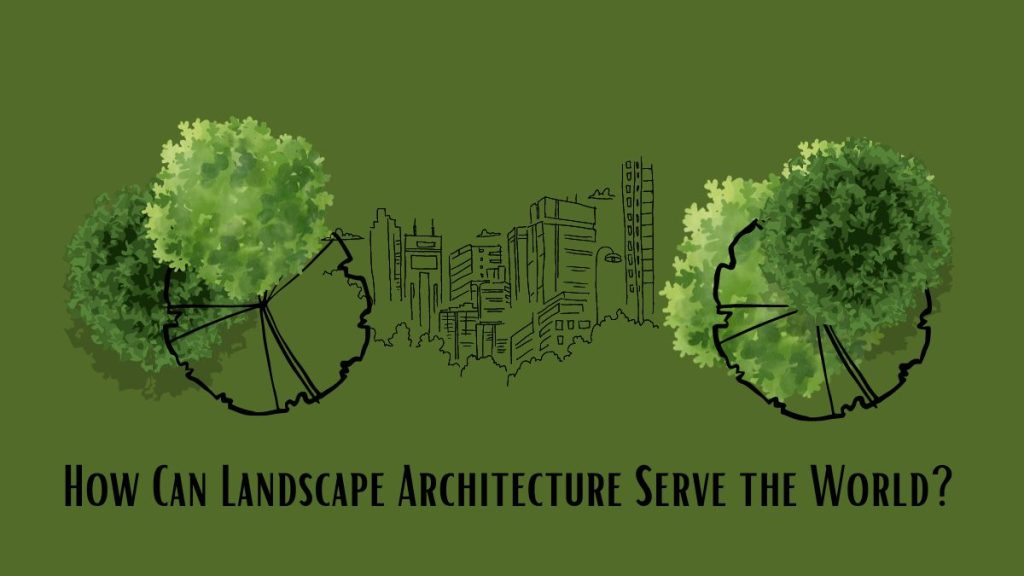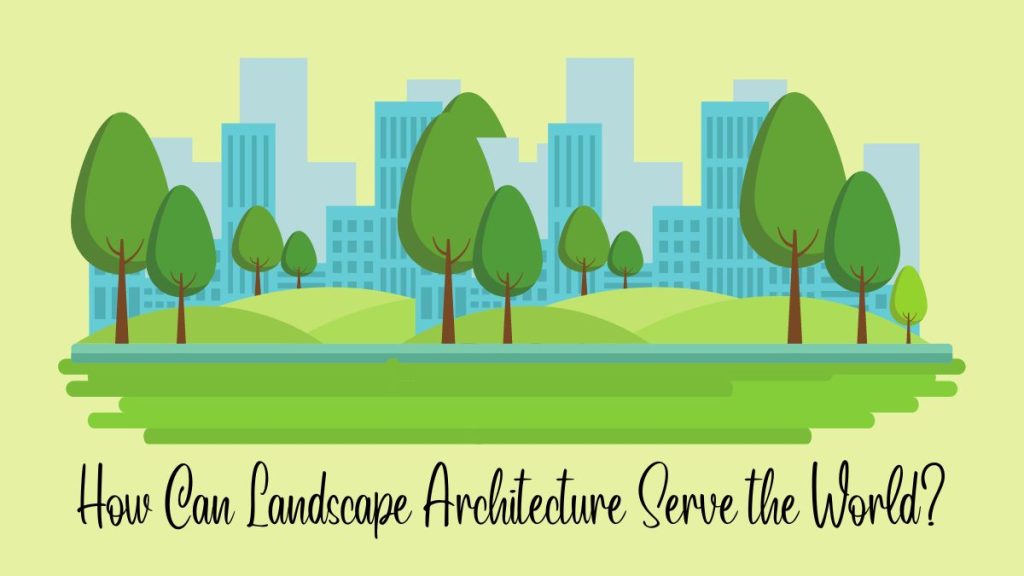Landscape architecture can enhance environmental sustainability and improve community well-being. It plays a pivotal role in addressing urban planning challenges. Basically, here we dig down how can landscape architecture serve the world today and how it gradually eco innovates the living condition?
Landscape architecture stands at the crossroads of art and science, offering innovative solutions to modern environmental issues. By designing spaces that are not only aesthetically pleasing but also functional and sustainable, landscape architects contribute significantly to the ecological health of urban and rural areas.
They create parks, gardens, and urban spaces that promote biodiversity, manage rainwater runoff, and provide recreational areas that enhance the quality of life. Through thoughtful design, landscape architects can help mitigate the effects of climate change, increase green cover, and foster communities that are connected to their environment. Their work supports the development of cities that are livable, enjoyable, and resilient against environmental challenges.
Related Article: How Does Architecture Help Society: Shaping Our World
You may also read: Types of Landscaping Garden: Transform Your Outdoor Space

Related Article: Benefits of Landscape Architecture: Enhance Your Space!
You may also read: Green Building Techniques: Eco-Friendly Design for Modern Living
The Green Revolution In Urban Spaces
The Green Revolution in Urban Spaces is transforming how we envision city life. As cities expand, the need for sustainable, green areas becomes crucial. Landscape architecture is stepping up to meet this challenge, creating vibrant, eco-friendly spaces that serve both the environment and urban dwellers.
Revitalizing Cities With Sustainable Design
Landscape architects use innovative design to make cities more sustainable. They turn grey areas into green havens. These green spaces help clean the air and provide areas for people to relax. They also manage storm water, reducing the risk of flooding.
- Rooftop gardens bring nature to the sky.
- Parklets turn parking spots into pop-up parks.
- Green walls adorn buildings with living plants.
Creating Eco-friendly Community Hubs
Community hubs are at the heart of the green revolution. These spaces foster social connections and promote well-being. They often feature:
| Feature | Benefit |
| Native plants | Support local wildlife |
| Outdoor seating | Encourage relaxation |
| Play areas | Invite active lifestyles |
These hubs use sustainable materials and practices. They often have rain gardens and permeable pavement. This helps manage water and reduce pollution.
Related Article: Modern Landscaping Designs: Transform Your Outdoor Space Today
Biodiversity Enhancement Through Design
The role of landscape architecture is vital in enhancing biodiversity. This branch of design focuses not just on aesthetics but on creating ecosystems that support life. Biodiversity enhancement through design bridges the gap between human activity and nature’s needs.
Integrating Native Flora And Fauna
Landscape architects prioritize the use of native plants in their projects. This practice supports local wildlife and maintains the natural balance. It also reduces maintenance and conserves water.
- Selection of native species that thrive in local conditions without extra resources.
- Designing spaces for native wildlife, including birds, insects, and mammals.
- Creating corridors that connect different habitats and allow for animal movement.
Habitat Restoration As A Design Principle
Habitat restoration is a key principle in landscape architecture. It involves bringing back lost ecosystems. This helps in preserving species and improving air and water quality.
| Action | Impact |
| Planting native trees | Increases oxygen production |
| Restoring wetlands | Provides water filtration |
| Creating pollinator gardens | Supports bee and butterfly populations |
Eco-friendly design choices can bring back native species. They can also reduce the carbon footprint of a landscape.
Climate Resilience In Landscape Architecture
Landscape architecture plays a vital role in shaping a world that can withstand climate challenges. Experts in this field design outdoor spaces that are not only beautiful but also sustainable. They ensure that communities can survive and thrive despite changing weather patterns.
Innovations In Storm water Management
Smart storm water management is key to protecting cities from floods. Landscape architects use green infrastructure to control water flow.
- Permeable pavements let water soak into the ground, reducing runoff.
- Rain gardens collect rainwater and beautify neighborhoods.
- Bioswales guide water away from streets, filtering it naturally.
These innovations help keep water clean and prevent damage during heavy rains.
Heat Island Mitigation Strategies
Cities get hot due to lots of concrete and little greenery. This effect is known as heat islands. Landscape architects fight this with cool designs.
| Strategy | Benefits |
| Tree Planting | Shade lowers temperature and adds oxygen. |
| Green Roofs | Plants on roofs absorb sunlight, cooling buildings. |
| Reflective Materials | Surfaces that reflect light reduce heat absorption. |
These strategies create cooler, more comfortable cities for everyone.
Related Article: Urban Design Ideas: Transform Your Cityscape with Innovation
Public Wellbeing And Social Spaces
In today’s fast-paced world, landscape architecture plays a vital role. It creates spaces that improve public wellbeing. Green spaces are not just pleasing to the eye. They are crucial for mental and physical health. Well-designed outdoor areas encourage people to gather, play, and relax. These spaces become the heart of a community.
Promoting Mental Health Through Nature
Landscape architecture offers a natural remedy for the stress of modern life. Designers focus on crafting serene environments. These places allow people to connect with nature. The presence of plants, water features, and open skies can reduce anxiety. It can boost mood and foster a sense of peace.
- Nature trails for calming walks
- Quiet zones with benches for reflection
- Community gardens for hands-on interaction with nature
Designing For Physical Activity And Community Engagement
Active design invites people of all ages to move and engage. Parks, playgrounds, and sports fields are more than just fun. They are tools to keep communities healthy. Such places promote regular exercise and social interaction. They are the backbone of a lively community.
| Feature | Benefit |
| Bike paths | Encourage cycling and connect neighborhoods |
| Outdoor gyms | Offer free exercise options for all |
| Playgrounds | Provide safe play areas for children |
Spaces for sports and play bring people together. They create strong bonds within the community. Landscape architecture helps make these connections happen. It turns empty lots into vibrant hubs of activity. These areas are where friendships form and communities thrive.
Related Article: Low Maintenance Landscaping Ideas for Front of House: Easy Tips

Related Article: Simple Landscape Design Ideas: Transform Your Yard Now!
Education And Advocacy In Landscape Design
Landscape architecture plays a pivotal role in shaping the future. It helps us learn about our environment. Professionals in this field advocate for sustainable practices. They design spaces for people and nature to thrive together. Education and advocacy are key. They help us understand the importance of thoughtful landscape design.
Interactive Learning Environments
Landscape architects create outdoor classrooms. These spaces inspire students and communities. They foster a connection with nature. The designs often include elements like vegetable gardens and weather stations. Kids get to see science in action. Schools use these gardens for hands-on learning.
Raising Environmental Awareness Through Landscapes
Landscapes can teach us about the environment. Designers use native plants to show the beauty of local ecosystems. They create habitats for wildlife. This attracts birds and butterflies. People learn about biodiversity. They see how their choices impact the world around them.
- Use of rain gardens to manage storm water
- Green roofs to reduce urban heat islands
- Conservation of natural resources in design choices
To know more about Landscape Architecture>>
Related Article: How to Landscape around Trees: Beautify Your Yard!
Related Article: Best Landscape Architecture Books to Transform Your Design Perspective
Conclusion
Landscape architecture shapes our environment in profound ways. By integrating sustainability, enhancing community well-being, and preserving natural habitats, it addresses global challenges effectively. Embracing this field can lead us towards a healthier, more balanced future with the earth. Let’s invest in landscape architecture to craft a world we’re proud to pass on.
Related Article: Best Landscaping Trees: 10 Must-Have Varieties!
Related Article: How Does Architecture Help Society: Shaping Our World

Pingback: Benefits of Landscape Architecture: Enhance Your Space! - SpaceArc
Pingback: How Does Architecture Help Society: Shaping Our World - SpaceArc
Pingback: Green Building Techniques: Eco-Friendly Design for Modern Living - SpaceArc
Pingback: Urban Design Ideas: Transform Your Cityscape with Innovation - SpaceArc
Pingback: Best Landscape Architecture Books to Transform Your Design Perspective - SpaceArc
Pingback: Simple Landscape Design Ideas: Transform Your Yard Now! - SpaceArc